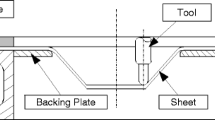Abstract
In order to use incremental sheet forming (ISF) in an industrial context, it is necessary to provide fast and accurate simulation methods for virtual process design. Without reliable process simulations, first-time right production seams infeasible and the process loses its advantage of offering a short lead time. Previous work indicates that implicit finite element (FE) methods are at present not efficient enough to allow for the simulation of AISF for industrially relevant parts, mostly due to the fact that the moving contact requires a very small time step. Finite element methods based on explicit time integration can be sped up using mass or time scaling to enable the simulation of large-scale sheet metal forming problems. However, AISF still requires dedicated adaptive meshing methods to further reduce the calculation times. In this paper, an adaptive remeshing strategy based on a multi-mesh method is developed and applied to the simulation of AISF. It is combined with subcycling to further reduce the calculation times. For the forming of a cone shape, it is shown that savings in CPU time of up to 80 % are possible with acceptable loss of accuracy, and that the simulation time scales more moderately when the part size is increased, so that larger, industrially relevant parts become feasible.






Similar content being viewed by others
References
Sebastiani G, Brosius A, Tekkaya AE et al. (2007) Decoupled simulation method for incremental sheet metal forming. In: AIP Conference Proceedings Volume 908. American Institute of Physics, pp 1501–1506
Sebastiani G, Steiner M, Brosius A et al. (2008) Investigating static condensation for efficient simulations of incremental sheet metal forming. In: Proceedings of the ANSYS Conference 2008, CD Rom
Hadoush A, Boogaard A (2009) Substructuring in the implicit simulation of single point incremental sheet forming. Int J Mater Form 2(3):181–189. doi:10.1007/s12289-009-0402-3
Hadoush A, van den Boogaard AH (2012) Efficient implicit simulation of incremental sheet forming. Int J Numer Methods Eng 90(5):597–612. doi:10.1002/nme.3334
Bambach M, Ames J, Azaouzi M et al. (2005) Initial experiment and numerical investigations into a class of new strategies for single point incremental sheet forming (SPIF). In: ESAFORM 2005: Proceedings of the Eight ESAFORM Conference on Material Forming, vol 2. The Publishing House of the Romanian Academy, Cluj-Napoca, Romania, pp 671–674
Dal Santo P, Robert C, Ayed LB et al (2009) On a simplified model for the tool and the sheet contact conditions for the SPIF process simulation. Key Eng Mater 410:373–379
Brunssen S, Bambach M, Hirt G et al. (2005) A primal-dual active set strategy for elastoplastic contact problems in the context of metal forming processes. In: R. Owen, E. Onate, B. Suarez (eds) Computational plasticity VIII. CIMNE, pp 823–826
Henrard C, Bouffioux C, Godinas A et al. (2005) Development of a contact model adapted to incremental forming. In: ESAFORM 2005: Proceedings of the Eight ESAFORM Conference on Material Forming, vol 2. The Publishing House of the Romanian Academy, Cluj-Napoca, Romania, pp 117–120
Bambach M, Hirt G (2007) Error analysis in explicit finite element analysis of incremental sheet forming. In: AIP Conference Proceedings Volume 908. American Institute of Physics, pp 859–864
Belytschko T, Mullen R (1978) Explicit integration of structural problems. Finite elements in nonlinear mechanics: 697–720
Hirt G, Kopp R, Hofmann O et al (2007) Implementing a high accuracy multi-mesh method for incremental bulk metal forming. CIRP Ann-Manuf Technol 56(1):313–316
Bambach M, Barton G, Franzke M et al (2007) Modelling of incremental bulk and sheet metal forming. Steel Res Int 78(10–11):751–755
Ramadan M, Fourment L, Digonnet H (2014) Fast resolution of incremental forming processes by the multi-mesh method. Application to cogging. Int J Mater Form 7(2):207–219
Grzhibovskis R, Bambach M, Rjasanow S et al (2008) Adaptive cross-approximation for surface reconstruction using radial basis functions. J Eng Math 62(2):149–160
Acknowledgments
The author would like to thank the German Research Foundation (DFG) for the support of the depicted research within the Cluster of Excellence “Integrative Production Technology for High Wage Countries”.
Author information
Authors and Affiliations
Corresponding author
Rights and permissions
About this article
Cite this article
Bambach, M. Fast simulation of incremental sheet metal forming by adaptive remeshing and subcycling. Int J Mater Form 9, 353–360 (2016). https://doi.org/10.1007/s12289-014-1204-9
Received:
Accepted:
Published:
Issue Date:
DOI: https://doi.org/10.1007/s12289-014-1204-9



